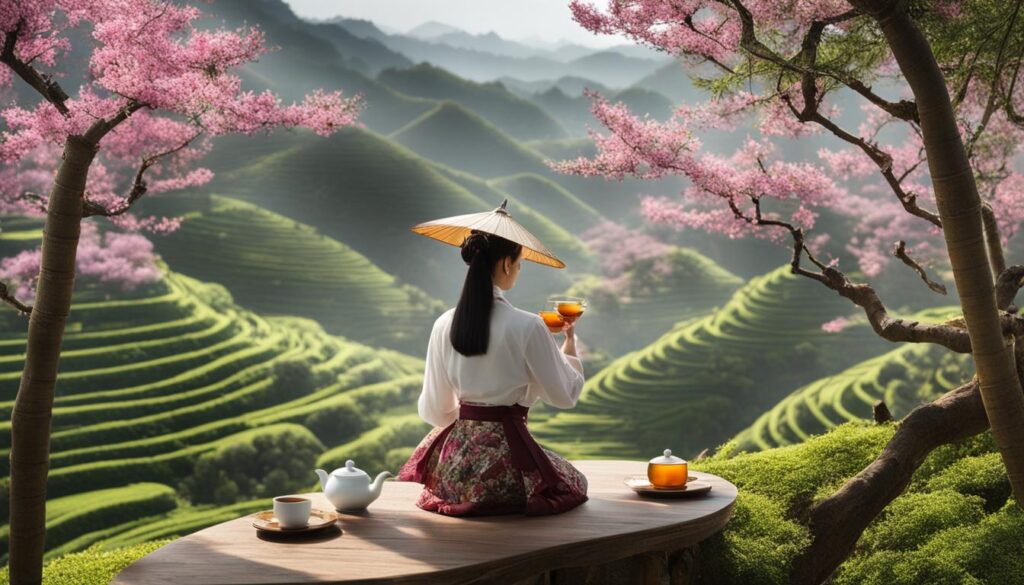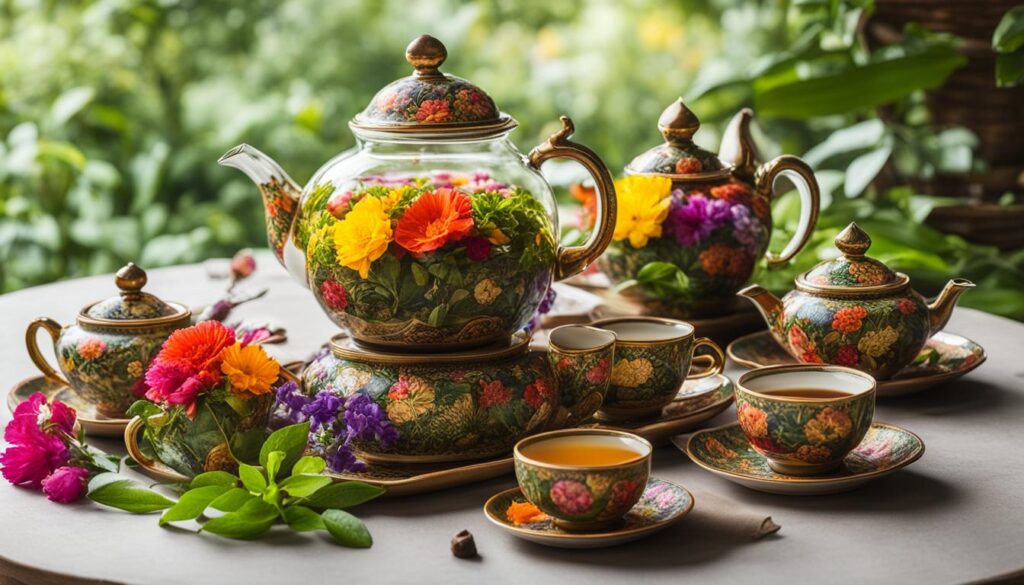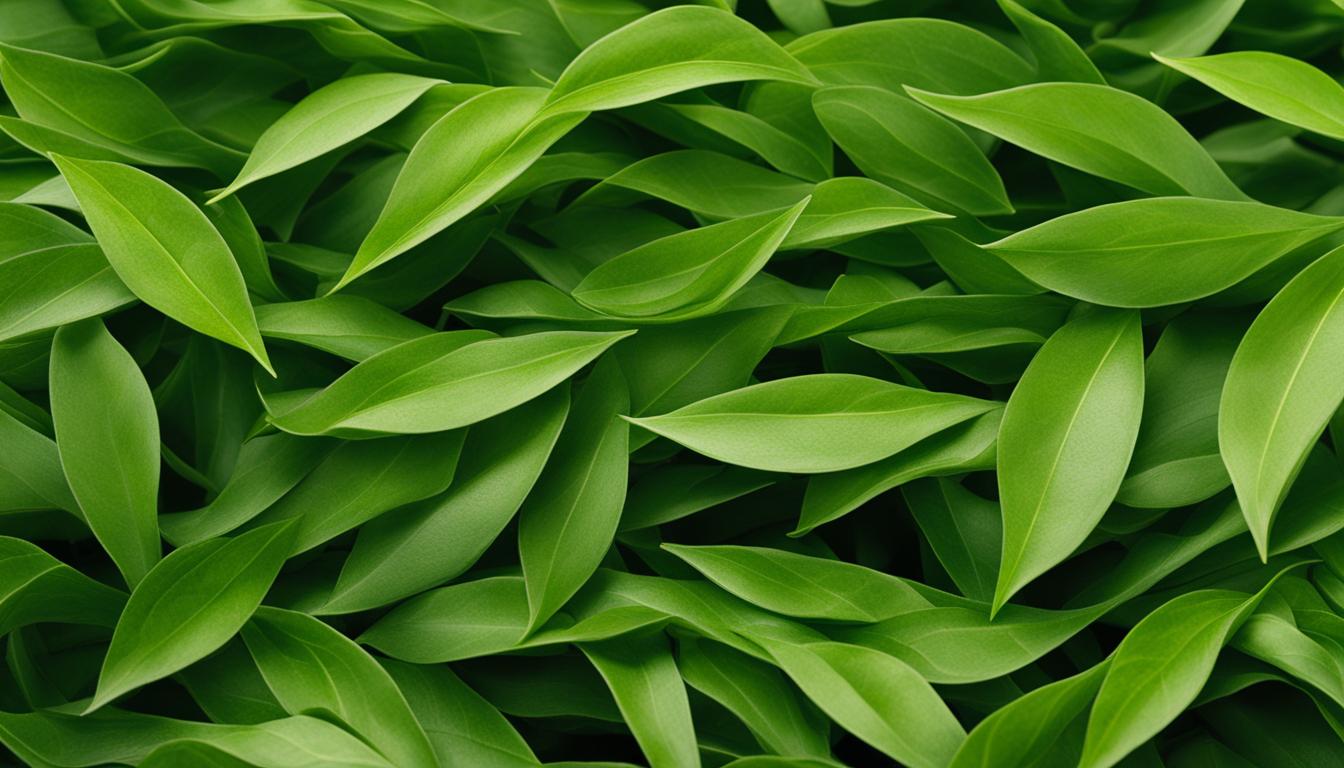Welcome to our ultimate tea tasting guide! Get ready to embark on a flavorful journey as we explore the diverse flavors and aromas of teas from different regions around the world. Whether you’re a seasoned tea enthusiast or new to the delightful world of tea, this guide is here to provide you with tips, insights, and recommendations for an unforgettable tea tasting experience.
Tea tasting is a delightful adventure that allows us to explore the unique blends and traditions of different tea regions. From the grassy and vegetal green teas of China and Japan to the floral and fragrant oolongs of Taiwan, each region offers its own distinct flavors and profiles. Join us as we delve into the intricacies of tea tasting, discovering the tea treasures from around the globe.
Key Takeaways:
- Tea tasting is a journey of exploration, allowing us to appreciate the diverse flavors and aromas of teas from different regions.
- Guided tea tasting experiences can provide valuable insights and enhance your tea tasting journey.
- Exploring regional tea flavors offers a unique opportunity to discover the nuances and traditions of different tea-growing regions.
- Each region has its own best teas for tasting, showcasing the richness and diversity of the world’s teas.
- With the right techniques and tips, you can cultivate a refined palate and elevate your tea tasting experience.
Understanding Green Tea: The Essence of China and Japan
Green tea is a beloved beverage known for its delicate flavors and numerous health benefits. When it comes to green tea, two countries stand out for their exceptional tea production: China and Japan. Each country has its own unique tea regions, cultivating green teas with distinct characteristics.
In China, green tea is typically pan-fired or oven-dried, resulting in a subtle toasty flavor and a fresh vegetal profile. The grassy and vegetal notes of Chinese green teas offer a refreshing experience that is both soothing and invigorating. Some popular green teas from China include Long Jing (Dragonwell) and Bi Luo Chun (Green Snail Spring).
On the other hand, Japanese green teas are steamed, which gives them a deep marine taste and a vibrant green color. The flavor profile of Japanese green teas is often described as seaweed-like, offering a unique and enjoyable taste. Matcha, Sencha, and Genmaicha are some well-known Japanese green teas that capture the essence of the country’s tea culture.
Both China and Japan have a rich tea heritage, and their green teas provide a delightful sensory experience. Whether you prefer the grassy and vegetal flavors of Chinese green teas or the fresh and fragrant profile of Japanese green teas, exploring the world of green tea allows you to appreciate the nuances of each region’s tea-making traditions and find your perfect cup.
Quick Facts: Green Tea from China and Japan
| Country | Green Tea | Flavor | Notable Varieties |
|---|---|---|---|
| China | Grassy and Vegetal | Long Jing (Dragonwell) Bi Luo Chun (Green Snail Spring) | |
| Japan | Fresh and Fragrant | Matcha Sencha Genmaicha |
“Green tea is nature’s gift, and its flavors tell the story of the countries that produce it. The grassy goodness of Chinese green teas and the vibrant freshness of Japanese green teas are a testament to the artistry and dedication of the tea growers.”
- Discover the diverse flavors of green tea by exploring Chinese and Japanese varieties.
- Experiment with different brewing techniques to enhance the taste and aroma of your green tea.
- Immerse yourself in the tea cultures of China and Japan by learning about their tea traditions and rituals.
- Experience the health benefits of green tea, known for its antioxidant properties and potential positive effects on the mind and body.
Exploring the World of Oolong: From Floral Taiwan to Woody China

Oolong tea is a versatile and complex category of tea that sits between green and black teas. Taiwan and China are renowned for their production of oolongs, offering a wide range of flavor profiles. Taiwanese oolongs, particularly those grown in high mountain regions, exhibit floral and fragrant characteristics, with hints of orchid and creamy undertones. In contrast, Chinese oolongs have a more woody and arboreal flavor, often reminiscent of toasted sesame seeds and roasted sweet potatoes.
As shown in the table below, Taiwanese oolongs are known for their delicate and sophisticated flavors, while Chinese oolongs offer a robust and earthy taste. The diverse flavor profiles make oolong teas a favorite among tea enthusiasts who appreciate the complexity and depth of this unique type of tea.
| Region | Flavor Profile |
|---|---|
| Taiwan | Floral and fragrant with hints of orchid and creamy undertones |
| China | Woody and arboreal, reminiscent of toasted sesame seeds and roasted sweet potatoes |
When exploring Taiwanese oolongs, it’s worth noting that high mountain oolongs, grown at elevations above 1,000 meters, are considered the crème de la crème of Taiwanese tea. These teas benefit from cool and misty climates, resulting in a unique flavor profile that showcases the natural sweetness and complexity of the leaves. High mountain oolongs are highly sought after by tea connoisseurs around the world.
Whether you prefer the delicate floral notes of Taiwanese oolongs or the robust earthiness of Chinese oolongs, exploring the world of oolong tea is an adventure filled with aromatic delights and diverse flavors. So, brew a cup of your favorite oolong and let its captivating taste transport you to the beautiful tea gardens of Taiwan and China.
Delving into the Richness of Black Tea: From Indian Estates to Chinese Plains
Black tea, known for its robust and full-bodied flavor, offers a delightful sensory experience for tea enthusiasts. It is produced in various regions worldwide, but two prominent tea-growing countries known for their distinct black teas are India and China. India’s Darjeeling tea, often referred to as the “Champagne of teas,” is celebrated for its fruity and ripe notes, reminiscent of cherries and stone fruits. On the other hand, China’s Yunnan black tea brings a woody and charcoal-like character to the cup, with hints of peanut shells and oak.
Darjeeling:
| Characteristics | Flavor Notes |
|---|---|
| Fruity and Ripe | Cherries, Stone Fruits |
| Region | Indian Estates |
Yunnan:
| Characteristics | Flavor Notes |
|---|---|
| Woody and Charcoal | Peanut Shells, Oak |
| Region | Chinese Plains |
Exploring the world of black tea allows you to appreciate the diverse flavors and brewing traditions of different regions. Whether you prefer the fruity and ripe Darjeeling or the woody and charcoal Yunnan, each cup of black tea offers a unique experience that captivates the senses. So indulge in the richness of black tea and discover the wonders that India and China have to offer.
“A cup of black tea is like a journey through the lush Indian estates or the picturesque Chinese plains, where every sip tells a story of flavor and craftsmanship.” – Anonymous
Savoring the Delights of Flavored Tea: From Citrus Infusions to Indulgent Chocolates

Flavored teas are a wonderful way to add a burst of excitement to your tea drinking experience. Whether you’re looking for a refreshing citrus-infused tea to brighten your morning or a decadent chocolate and nut blend to indulge in after a long day, the world of flavored teas has something for everyone. These delightful blends combine the best of both worlds, infusing the base tea leaves with a variety of flavors and aromas to create a truly unique and enjoyable cup.
One of the most popular flavored teas is Earl Grey, a classic black tea infused with the aromatic essence of bergamot citrus. The bright and uplifting flavors of citrus and sunshine complement the rich and robust base of black tea, creating a harmonious and refreshing blend. Earl Grey is the perfect choice for those seeking a tea that is both familiar and invigorating.
For a more delicate and elegant option, Jasmine Pearls are a must-try. These green tea pearls are hand-rolled and scented with fresh jasmine blossoms, resulting in a tea that is both fragrant and flavorful. The gentle floral notes and the smoothness of the green tea create a soothing and enchanting cup that is perfect for any occasion.
The world of flavored teas offers a wide array of options to suit every taste and preference. So, why not embark on a journey of flavors and indulge in the delightful delights of flavored teas?
| Flavored Tea | Description |
|---|---|
| Earl Grey | A classic black tea flavored with aromatic bergamot citrus oil. A bright and refreshing blend. |
| Jasmine Pearls | Green tea scented with fresh jasmine blossoms. Delicate and fragrant, perfect for relaxation. |
| Citrus Infusion | A blend of various citrus fruits, like lemon, orange, and grapefruit, creating a zesty and invigorating cup. |
| Chocolate and Nut | A rich and indulgent blend of cocoa nibs, roasted nuts, and black tea. Perfect for a cozy evening treat. |
As you explore the world of flavored teas, don’t be afraid to try new and unique blends. From fruity and floral infusions to indulgent and comforting combinations, there are endless possibilities to tantalize your taste buds. So, grab your favorite teacup, steep a cup of flavored tea, and savor the delightful delights that await you.
Embracing the Unique Smokiness of Tea: From Lapsang Souchong to Roasted Tieguanyin
When it comes to exploring the fascinating world of tea, there’s one category that stands out for its bold and distinctive flavor profile – smoked tea. Known for its earthy and smoky notes, smoked teas offer a unique and captivating taste experience that you won’t find in any other type of tea.
One of the most famous smoked teas is Lapsang Souchong, a Chinese black tea that undergoes smoking during the processing stage. The result is an intense and robust cup of tea with a pronounced smoky aroma and a hint of charcoal. This bold and aromatic tea is adored by tea enthusiasts who appreciate its complex flavor profile and the depth it adds to their tea collection.
Another smoked tea to explore is Roasted Tieguanyin, an oolong tea also from China. This tea is known for its deep and intense smoldering flavor, reminiscent of a smoky campfire. With its rich and roasted taste, Roasted Tieguanyin offers a truly unique tea experience that is both comforting and invigorating.
Smoked teas like Lapsang Souchong and Roasted Tieguanyin are perfect for those who enjoy bold and adventurous flavors. The smoky elements add a layer of complexity to the tea, elevating it to a whole new level. So if you’re looking to expand your tea horizons and try something different, don’t miss out on the unique smokiness of these teas.
Smoked Tea Comparison
| Tea | Origin | Flavor Profile |
|---|---|---|
| Lapsang Souchong | China | Intense smokiness with hints of charcoal |
| Roasted Tieguanyin | China | Deep and smoldering with roasted notes |
As you embark on your tea tasting journey, don’t forget to embrace the unique smokiness of tea. Lapsang Souchong and Roasted Tieguanyin are just two examples of the many wonderful smoked teas available. So take a sip, close your eyes, and let the smoky flavors transport you to a world of bold and aromatic sensations.
Unveiling the Earthiness of Fermented Tea: From Shu Pu-erh to Woody Ruyi Bingcha
Fermented teas offer a unique and captivating taste experience, characterized by their distinctive earthiness and depth of flavor. Two notable examples of fermented teas are Shu Pu-erh and Ruyi Bingcha, each showcasing their own intricate profiles that tea enthusiasts can appreciate.
Shu Pu-erh: This ripe pu-erh tea from Yunnan, China, undergoes a special pile-fermentation process that imparts a rich and earthy character. The tea leaves are piled together, allowing for microbial fermentation that transforms the flavor and aroma of the tea. The resulting brew displays subtle caramelized notes and a distinct earthy undertone. Shu Pu-erh is highly regarded for its potential health benefits and is often consumed as a digestive aid.
Ruyi Bingcha: Originating in Yunnan, Ruyi Bingcha is a black tea that offers a unique and woody taste experience. The tea leaves are carefully processed and aged, developing a pronounced flavor profile reminiscent of peanut shells and oak. This tea has a deep and complex flavor, making it a favorite among tea connoisseurs who appreciate its rich and smoky qualities.
Discover the enchanting world of fermented teas, where earthy and fermented flavors take center stage. From the caramelized and woody notes of Shu Pu-erh to the captivating richness of Ruyi Bingcha, these teas offer a truly unique and indulgent tasting experience.
When exploring fermented teas, it is important to brew them with care to unlock their full potential. Use water that is just below boiling temperature, around 195-205°F (90-96°C), to ensure optimal extraction of flavors. Steep the leaves for 3-5 minutes, or adjust the steeping time based on your desired strength. Experiment and savor the different flavor notes that emerge with each sip, immersing yourself in the richness of fermented teas.
So, embrace the earthiness and complexity of fermented teas and delve into the captivating world of Shu Pu-erh and Ruyi Bingcha. With their distinctive flavors and intriguing aromas, these teas are sure to captivate your senses and leave you craving for more. Elevate your tea experience with these exceptional fermented teas and enjoy a truly unforgettable tasting journey.
| Tea | Origin | Flavor Profile |
|---|---|---|
| Shu Pu-erh | Yunnan, China | Caramelized and earthy |
| Ruyi Bingcha | Yunnan, China | Woody and smoky |
Conclusion
Tea tasting is not just a leisurely activity; it is a journey of exploration and discovery. We have delved into the intricacies of tea tasting techniques and tips, guiding you on how to cultivate a refined tea tasting palate. By following these guidelines, you can enhance your overall tea experience and fully immerse yourself in the wonders of tea.
Each tea region offers its own best teas for tasting, showcasing the diversity and richness of the world’s teas. Whether you are sipping on the delicate flavors of Chinese green tea or indulging in the robustness of Indian black tea, every cup tells a unique story. Through tea tasting, you have the opportunity to uncover the hidden gems and remarkable flavors that each region has to offer.
So, grab your teacup, take a moment to savor the aromas, and embark on a flavorful adventure. Discovering world teas through tasting is not just about nourishing your taste buds; it’s about connecting with different cultures, traditions, and the rich history of tea. Cheers to the endless possibilities and the beautiful world of tea that awaits!
FAQ
What is tea tasting?
Tea tasting is the process of evaluating the flavors and aromas of different teas. It involves using your senses to explore the nuances and characteristics of each tea, from the region it comes from to the way it is processed.
How do I taste tea properly?
To taste tea properly, start by smelling the dry leaves and noting their aroma. Then, steep the tea according to the recommended brewing instructions and observe the color and clarity of the liquor. Take a sip and let the tea coat your palate, paying attention to the taste, mouthfeel, and aftertaste. Take your time and savor the flavors to fully appreciate the tea.
What are the best teas for tasting?
The best teas for tasting depend on your personal preferences. However, some popular choices for tea tasting include green teas from China and Japan, oolongs from Taiwan and China, black teas from India and China, flavored teas with unique additions, smoked teas with a bold flavor, and fermented teas with an earthy profile.
Can I taste teas from different regions at the same time?
Yes, you can taste teas from different regions at the same time. It can be a fun and educational experience to compare the flavors and aromas of teas from different parts of the world. Just make sure to cleanse your palate between tastings to fully appreciate each tea’s unique characteristics.
How can I enhance my tea tasting experience?
To enhance your tea tasting experience, make sure to use high-quality tea leaves, filtered water, and the correct brewing parameters. Experiment with different steeping times and temperatures to find the ideal balance of flavors. Additionally, try pairing your teas with complementary foods to create a sensory journey for your taste buds.
Are there any health benefits to tea tasting?
While the primary goal of tea tasting is to appreciate the flavors and aromas of different teas, many teas also offer health benefits. For example, green teas are known for their antioxidant properties and potential weight management benefits. Black teas may promote heart health and digestive wellness. However, it’s important to consult with a healthcare professional for personalized health advice.
What should I do if I don’t like the taste of a tea?
If you don’t enjoy the taste of a particular tea, it’s perfectly fine. Taste preferences are subjective, and not every tea will appeal to everyone. You can always try different teas or explore other flavors within the same tea category to find something that suits your palate.
Can I reuse tea leaves for tasting?
Yes, you can reuse tea leaves for tasting, especially with certain types of teas like oolongs and pu-erhs. These teas can often be steeped multiple times, each time offering different flavors and aromas. Just adjust the steeping parameters accordingly and enjoy the evolving taste of the tea with each infusion.
Where can I find more information about tea tasting?
There are many resources available to learn more about tea tasting. You can explore books, online articles, tea forums, and even attend tea tasting workshops or classes. Additionally, reaching out to tea professionals or enthusiasts can provide valuable insights and recommendations for your tea tasting journey.





